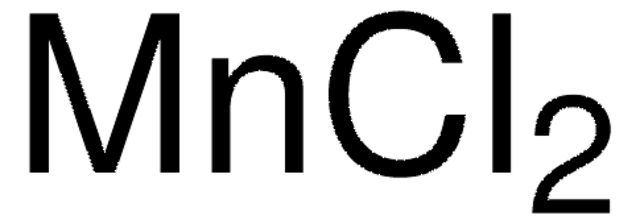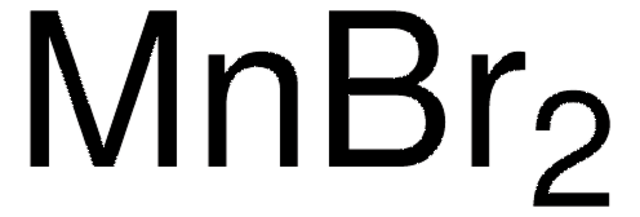244589
Manganese(II) chloride
powder and chunks, ≥99% trace metals basis
Synonym(s):
Manganese dichloride, Sacchite
About This Item
Recommended Products
grade
for analytical purposes
Quality Level
Assay
≥99% trace metals basis
form
powder and chunks
impurities
≤10000.0 ppm Trace Metal Analysis
mp
652 °C (lit.)
density
2.98 g/mL at 25 °C (lit.)
application(s)
battery manufacturing
SMILES string
Cl[Mn]Cl
InChI
1S/2ClH.Mn/h2*1H;/q;;+2/p-2
InChI key
GLFNIEUTAYBVOC-UHFFFAOYSA-L
Looking for similar products? Visit Product Comparison Guide
Related Categories
General description
Application
- As a precursor to synthesize manganese oxide nanoparticles.
- To fabricate Mn(ll) coordinated polyaniline electrodes for supercapacitors.
- To prepare thermally activated high anodic capability MOFs for Li-ion batteries.
- As a starting material to synthesize polymer composite films withenhanced optical properties.
Signal Word
Danger
Hazard Statements
Precautionary Statements
Hazard Classifications
Acute Tox. 3 Oral - Eye Dam. 1 - STOT RE 2
Target Organs
Brain
Storage Class Code
6.1D - Non-combustible acute toxic Cat.3 / toxic hazardous materials or hazardous materials causing chronic effects
WGK
WGK 2
Flash Point(F)
Not applicable
Flash Point(C)
Not applicable
Personal Protective Equipment
Regulatory Listings
Regulatory Listings are mainly provided for chemical products. Only limited information can be provided here for non-chemical products. No entry means none of the components are listed. It is the user’s obligation to ensure the safe and legal use of the product.
PRTR
Class I Designated Chemical Substances
ISHL Indicated Name
Substances Subject to be Indicated Names
ISHL Notified Names
Substances Subject to be Notified Names
JAN Code
244589-BULK:
244589-1KG:
244589-10G:4548173933580
244589-250G:4548173933597
244589-50G:4548173933603
244589-VAR:
Choose from one of the most recent versions:
Already Own This Product?
Find documentation for the products that you have recently purchased in the Document Library.
Customers Also Viewed
Articles
Lithium-Ion Battery Performance: Dependence on Material Synthesis and Post‑Treatment Methods
Our team of scientists has experience in all areas of research including Life Science, Material Science, Chemical Synthesis, Chromatography, Analytical and many others.
Contact Technical Service









